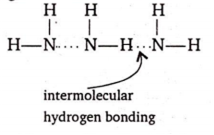 Multiple Choice Questions
Multiple Choice QuestionsReaction of HNO3 with I, S, P and C gives respectively
HIO3, H2SO4, H3PO4, and CO2
HIO3, H2SO3, H3PO4, and CO2
HIO2,H2SO4, H3PO4, and CO
I2O5, SO2, P2O, and CO2
Red P can be obtained by white P by
Heating it with a catalyst, in an inert atmosphere
Distilling it in an inert atmosphere
Dissolving it in CS2 and crystallizing
Melting it and pouring the liquid into water
Fluorine is the best oxidising agent because it has :
highest electron affinity
highest E
highest E
lowest electron affinity
NH3 has much higher boiling point than PH3 because
NH3 has larger molecular weight
NH3 undergoes umbrella inversion
NH3 forms hydrogen bond
NH3 contains ionic bonds whereas PH3 contains covalent bonds.
C.
NH3 forms hydrogen bond
Boiling point of ammonia is much higher than phosphine. It is due to extensive hydrogen bonding found in ammonia.

When I2 is passed through KCl, KF and KBr solutions:
Cl2 and Br2 are evolved
Cl2 is evolved
Cl2, Br2 and F2 are evolved
None of the above
